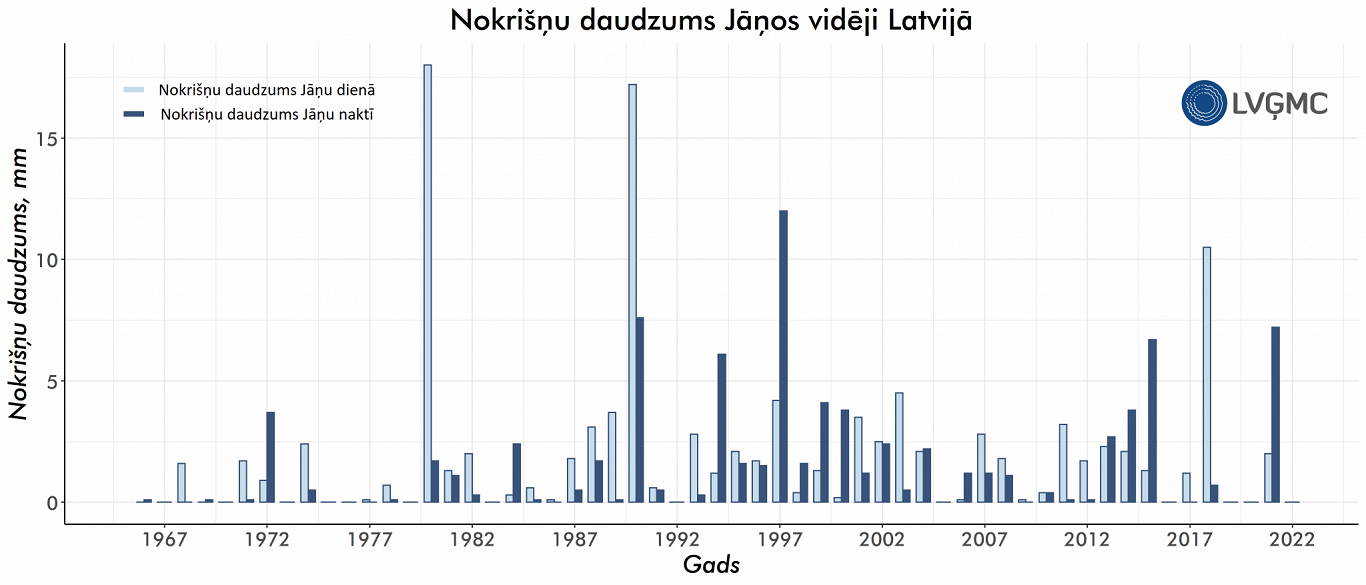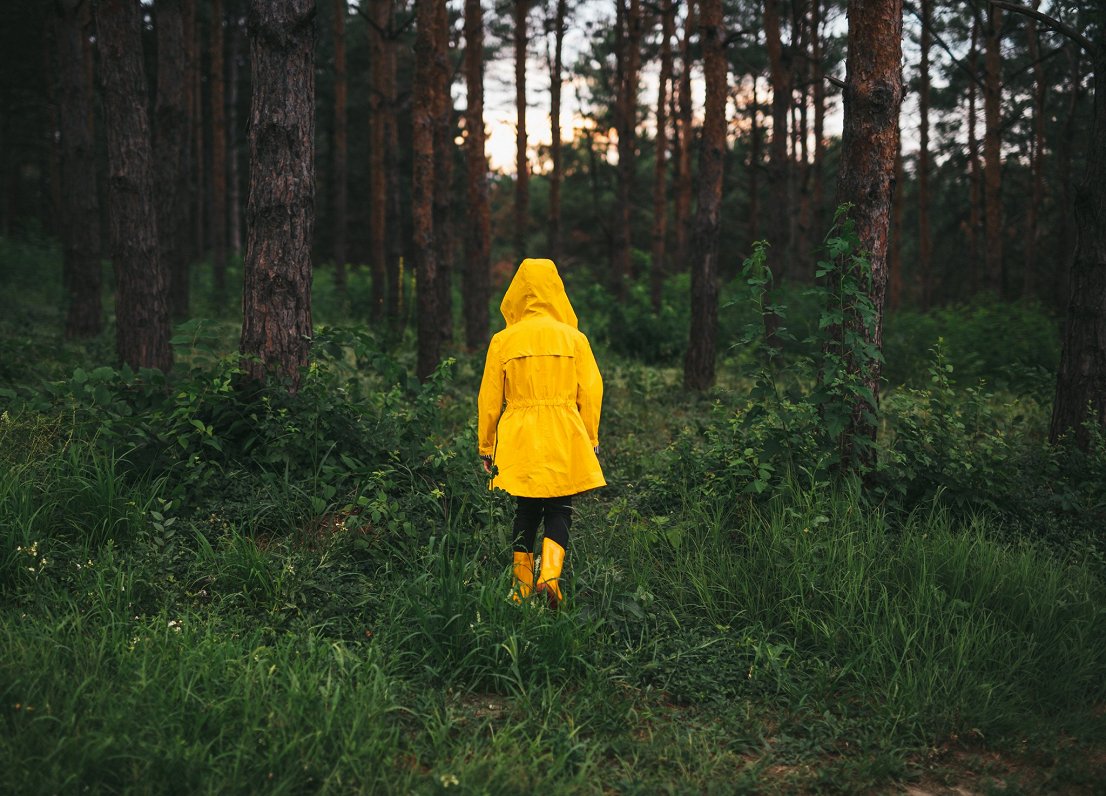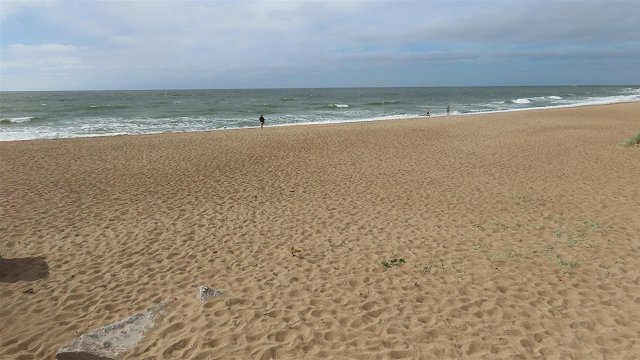The Latvian Environment, Geology and Meteorology Center (LVĢMC) attempted to provide an answer June 22 by looking at its historic meteorological data.
"Looking at the historical data from 1966 on the precipitation on Midsummer's Eve, we can conclude that although in almost every year at least in one region of Latvia had rain on Midsummer's Eve [June 23], the probability of precipitation in specific regions is from 20% in Piedruj to 44% in Stende," said the LVĢMC.
"In general, on average in Latvia, the probability of expecting precipitation on Midsummer night is 30%. Out of the last 57 Midsummer nights, 9 were spent without rain in the whole of Latvia, and the last time such a Midsummer night was experienced was in 2022, but on another 9 Midsummer nights it rained only in some places, and the average amount of precipitation in Latvia did not reach 0.1 mm."
The rainiest Midsummer Eve was in 1997, when the average amount of precipitation in Latvia was 12 mm, and as much as 58 mm fell in Krāslava.
Interestingly, Midsummer's Day [June 24, Jāņi day itself] is usually wetter than Midsummer's Eve, because the probability of precipitation on Midsummer's Day ranges from 23% in Pāvilosta to 51% in Skrīveri, but on average is 38% in Latvia.
Also, the highest amount of precipitation in the last 56 years was greater on Midsummer's Day than on Midsummer's Night: 68.4 mm in 1980 at the Pravini observation station, Tukums district – so in that sense, maybe the old saying does have some truth, after all.
Tautā iegājies teiciens “līst kā pa Jāņiem”, bet vai tiešām Jāņiem ir ierastas stipras lietavas?
To centāmies noskaidrot, ielūkojoties iepriekšējo Jāņu laikapstākļos: https://t.co/Y3tr1lYu2M
Lustīgu līgošanu! 🌿#klimats #MeteoLV #LīstKāPaJāņiem pic.twitter.com/okzutGMUEk
— Meteo.lv (@LVGMC_Meteo)
June 22, 2023
However, the LVĢMC goes further still in its quest for folkloric facts.
"We see that Midsummer Eve and Midsummer Day were more often spent without precipitation, so one might think that there is no real basis for the saying about Midsummer being full of precipitation. However, it is often pointed out that the saying refers to the shortest night of the year, or Solstice, which is a few days before Midsummer. Therefore, we also looked at the probability of precipitation for the night of June 21, which is usually the shortest night of the year, and concluded that the shortest night of the year is even drier than Midsummer's Eve, because since 1966 the probability of precipitation is from 18% in Ventspils and Vičaks to 40% in Lubans, while on average in Latvia it is 26%."

But what about temperatures, which have a major impacton how pleasant it is to traipse across the meadows in search of fern flowers? The average daily temperature during the climatic standard norm period (1991-2020) in Latvia on June 23 and 24 is +15.6 degrees Celsius.
On Midsummer Eve, the average temperature in Latvia drops to +10.8 C. The warmest Midsummer nights are usually in Rīga, where the minimum air temperature is on average +13.1 C, while the coldest are in Zosēni, where the air temperature drops to an average of +9.6 C on Midsummer Eve.
The coldest Midsummer Eve was in 1992, when the average lowest air temperature in Latvia was +3.1 C, but in Zosēni the air temperature dropped to a bone-chilling +0.7 C.
The warmest Midsummer Eve was in 2021, when the average minimum air temperature in Latvia was +17.0 C. But last year in 2013 in Rīga, when it was a tropical night in the capital, the air temperature did not drop below +20.5 C. On Midsummer's Day, the air temperature in Latvia rises to an average of +20.2 C. The warmest Midsummer days are usually in the central and eastern regions of the country, while the coldest ones are in the coastal regions.
The hottest days of Midsummer were in 2021, when the average maximum air temperature in Latvia on these days was +28.9 C, and in Madona the highest air temperature of +33.2 C was recorded on Midsummer's Day on June 23 and 24.
"Climate change has also affected the weather at Midsummer," said the LVĢMC. "Comparing the current climatic norm period with previous years, we can conclude that nowadays precipitation is more likely to be expected on Midsummer's Eve. If at the beginning of the considered period, on Midsummer night, the average rainfall in Latvia was 20% of the years, then in the period of the current norm, this probability is more than twice as high – 42% of the years."






























